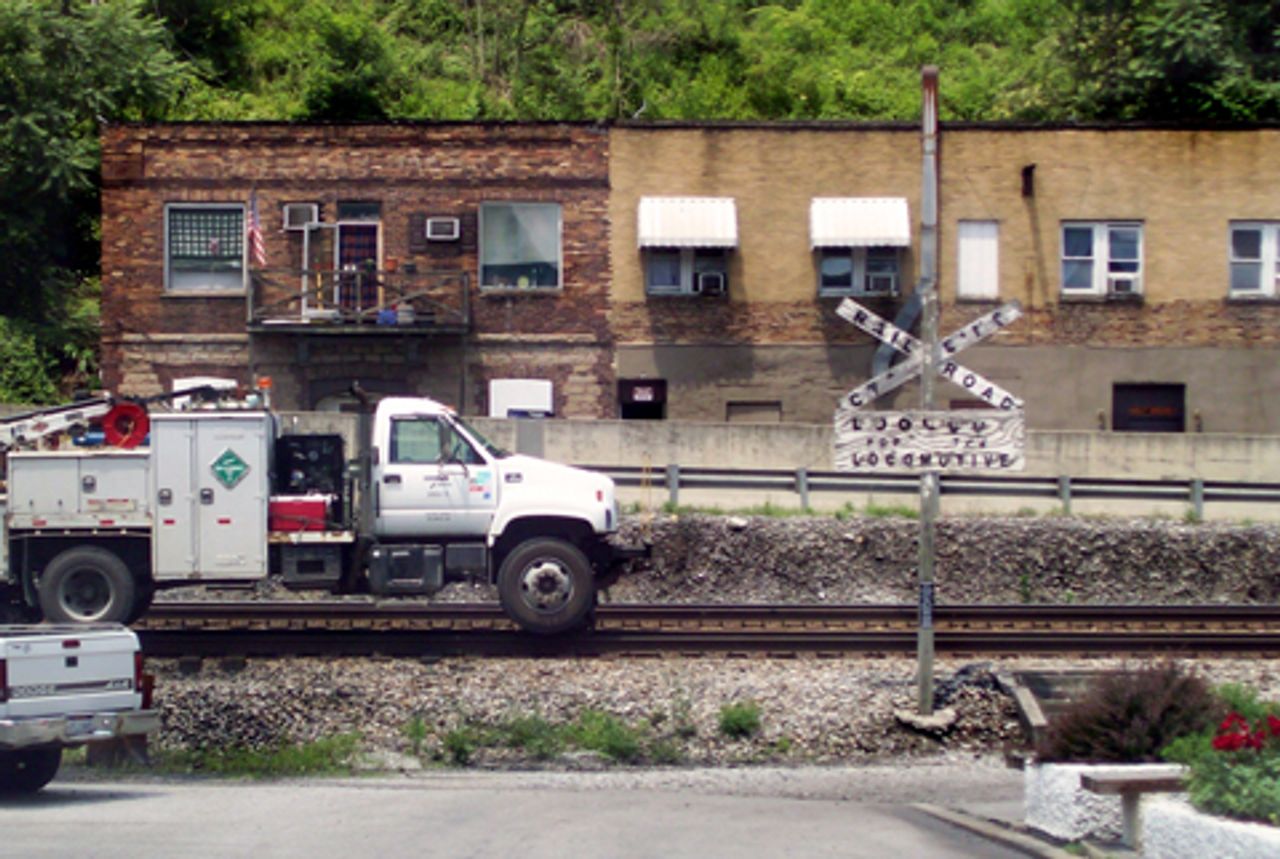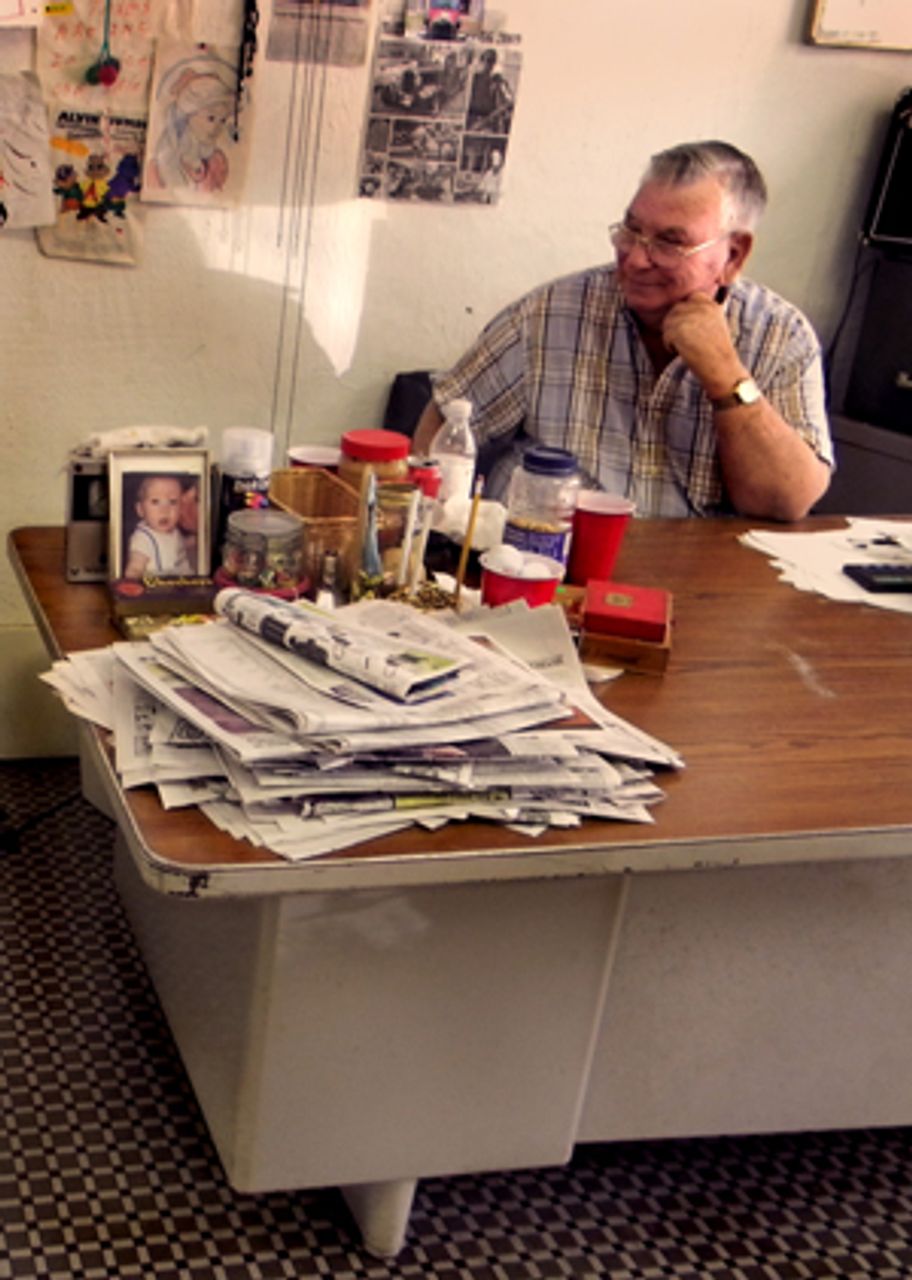Situated in the steep mountains of Mingo County, West Virginia, the town of Matewan has a total area of no more than half a square mile. This small town, which has earned a place in history for the struggles of the coal miners who called it home in the first part of the twentieth century, consists of little more than two roads and two rows of buildings. On one side of town, a floodwall offers protection from the rising waters of the Tug Fork river; on the other side, the Norfolk Southern railroad brings an endless string of coal cars through town, covering everything in a film of dust.
Just 475 people currently live in Matewan, according to the most recent estimates from the US Census Bureau. Of this small group, 31.9 percent of individuals and 16.8 percent of families live below the poverty line. Nearly 43 percent are classified as disabled. The median household income, according to the 2000 Census, stands at a staggeringly low $13,529.
 UMWA building in Matewan
UMWA building in MatewanThe town is dominated on one end by a large United Mine Workers of America (UMWA) building. Considered alongside the conditions that surround it and the stories of the people who live there, one might say the UMWA building stands as a monument to that organization’s betrayals of the workers in the region.
Matewan is home to one of the most significant events in the history of labor struggles in the United States. In 1920, the town’s miners fought to unionize their mines and were faced with bitter opposition from the Stone Mountain Coal Company. On May 19 of that year, 11 thugs from the notorious Baldwin-Felts Detective Agency hired by the company arrived in town to evict union miners from their company-owned homes. Later that day, as the Baldwin-Felts thugs prepared to board a train and leave town, they were stopped by pro-union sheriff Sid Hatfield who had the support of several armed miners who were hiding out of sight of the Baldwin-Felts agents.
The confrontation between Hatfield and the agents escalated into a massive gun battle. When the shooting was over, seven of the Baldwin-Felts gang were killed. Matewan’s mayor, Cabel Testerman, and two miners also died in the melee.
The history of the Matewan Massacre is still very much alive in the town today. Bullet holes from the 1920 battle still scar the facade of one building.
 Norfolk Southern rail line and apartment buildings in Matewan
Norfolk Southern rail line and apartment buildings in MatewanThe fate of Matewan has all along been bound up with that of the coal industry. While the militancy of the miners in Southwestern West Virginia and throughout Appalachia won many important gains and succeeded in unionizing the majority of the region’s coalfields throughout the 1920s and 1930s, the ensuing decades brought the collapse of the coal industry and a reactionary assault on miners’ living conditions. The UMWA, which from the beginning worked to divert the militancy of its rank-and-file workers and keep their struggles confined to the realm of official bourgeois politics, bears an enormous responsibility for the devastating conditions that working people in the region suffer today.
World Socialist Web Site reporters spoke to residents about the collapse of social conditions in the town.
 Bill
BillBill is a 74-year-old former mine superintendent who runs a flea market in Matewan. “This used to be a booming town, until the big flood in 1977,” he told WSWS reporters. “After that, the government put in the floodwall and rebuilt the highway further up the hill, so it completely bypassed the town. In both of those projects, they tore out a lot of people’s houses; that’s when the population collapsed.”
“I was always in mining,” he said. “I started work in 1956 in a little mine near here. I worked until 1992, when I broke my back in an accident.”
“Today if you need medical care, you have to travel for hours. I go all the way to Lexington, Kentucky, for my back. When there are mine accidents or bad car wrecks, a helicopter comes in. If you got hurt and took an ambulance, you would die. There are no hospitals close enough to treat you. Matewan has a clinic; we call it the ‘first aid hut’ because it barely has any supplies and it’s only open about twice a week.”
 Becky, Paige, and Sue
Becky, Paige, and SuePaige, Becky, Sue, and Junior are young Matewan residents. “The economy sucks,” Paige said. “You work in the coal mines, you’ll get killed. You want a shop clerk job, go across the river.”
Becky told the WSWS, “It’s hard to believe, but Matewan used to be so nice. There was a theater, there were nightclubs. Now there aren’t even any restaurants left. The town is dead.”
“Did you see the library?” Paige asked. “Basically a metal shed with two computers, open a couple times a week, you have to cross the train tracks and the highway to get to. It’s a joke.”
WSWS correspondents asked them what they did for fun. Junior said, “Go down to the liquor store, grab some beer, then go sit on the outside of the floodwall and fish.” Reporters asked if they ate the fish. “Oh, hell no!” several replied. Becky said, “You can’t eat the fish—you’ll get sick if you do. You do not eat fish out of this river. We just catch them for fun and then throw them back.”
 Scott
ScottScott Campbell works at the Matewan Depot. “I moved here a year ago to work at a restaurant, but it folded a month later,” he said. “The last restaurant in town just closed last week.”
“Thousands of people used to live here,” he told the WSWS. “Before the 1977 flood, coal trucks and everything used to come right through the center of town, where the old highway was. The only thing left for people to come into town for now is the post office—which people have to come in for to get their mail, because we don’t have anybody that does delivery. People don’t even have mailboxes.”
“The liquor store is the busiest place in town,” Scott said. “There’s a few people that own a bunch, and a bunch that don’t own anything.”
Scott takes odd jobs rebuilding and repainting around town. He explained, “The coal off the train, mixed with the diesel, coats everything and makes the town dingy. People don’t bother to wash their cars because they get dirty again so quickly.
“Here in this place where nobody’s got a dime, you have trains full of millions and millions of dollars passing through. Every five cars is a million dollars, and there are a hundred cars on a train, and the trains come through every 20 minutes—well, you do the math.”
The social crisis in Appalachia: Part 1 | Part 2 | Part 3 | Part 4 | Part 5
Interviews and related material: 1 | 2 | 3 | 4 | 5
